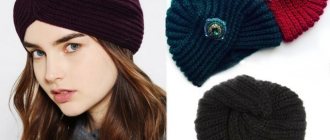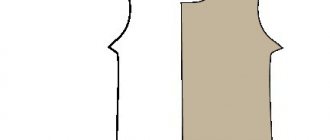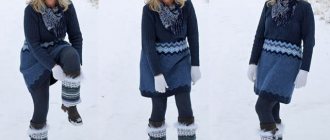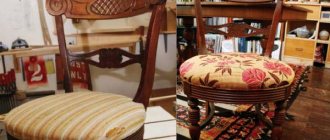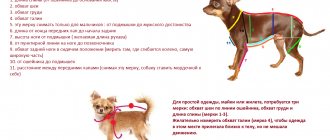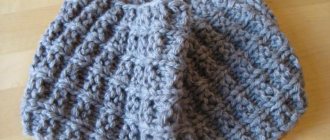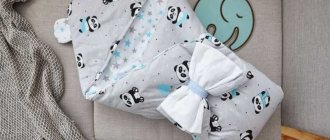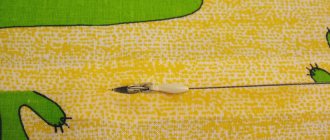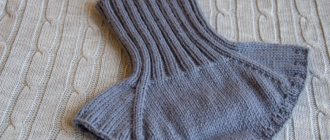Types and features of women's sweaters
Today you can often see hand-knitted women's sweaters in designer collections. They are usually divided into three categories:
- bulky knitting from thick yarn;
- made from threads of moderate thickness with openwork patterns;
- from fine yarn with different patterns.
Before you start knitting a sweater, you should decide which option you need. If you plan to wear the product in the summer, pay attention to openwork models. An item with a large voluminous pattern is suitable for the cold season.
Oversized pullovers are incredibly popular. But we should not forget that the apparent lack of shape and size of such sweaters require considerable diligence from the craftswoman.
Wrap sweater and leg warmers with knitting needles for yoga
A simple knitted wrap sweater for women, made of acrylic yarn. The jacket is complemented by leggings; all of these are an excellent choice for those who love to do yoga. A novice needlewoman can handle knitting such a sweater. The partial knitting technique is used for the ties. The leg warmers are knitted in the round with an elastic band on stocking needles. Description given for all sizes.
Blouse with wrap Simple option
Dimensions
Small (Medium, Large and Extra Large) Bust: 75-80 (85-90, 95-100, 105-110) cm Bust (finished product): 87.5 (97.5, 107, 116) cm Length: 46 (47.5 , 48.5, 50) cm
Materials
Yarn RED HEART® “Eco-Ways™ (70% acrylic, 30% polyester, 113 g/170 m) 4 (5, 5, 6) skeins, circular and stocking needles 4.5 mm, circular knitting needles 5 mm
Description of the sweater with knitting needles
Back
On 4.5 mm needles, cast on 75 (83, 91, 99) sts and knit with 1x1 rib (k1, p1) for 2 rows. Switch to 5 mm needles and continue knitting in stockinette stitch to a back height of 26.5 (27, 27.5, 28) cm from the cast-on edge. At the beginning of the trail. 2 rows for the armholes of the sleeves, close 3 (4, 5, 6) sts and then decrease 1 st on each side in the next row. 5 (5, 6, 6) persons. = 59 (65, 69, 75) sts. When the back height is 46 (47.5, 48.5, 50) cm bind off the loops.
SHORT CARDIGAN WITH WRAP.ZARA 2021. knitted clothes. finished work. knitted wardrobe.
Left shelf
On 4.5 mm needles, cast on 100 (104, 108, 112) stitches and perform 2 rows with an elastic band as for the back. Switch to larger needles and continue:
THE MOST TENDER AND VERY BEAUTIFUL CARDIGAN SWEATSHIRT WITH SMELL. fashionable knitting. knitted ideas. knitting.
3rd row: knit stitch. before last 15 stitches in a row, turn knitting.
Row 4 and purl all over: purl.
Row 5: knit st. before last 30 stitches of the row, turn knitting.
Cardigans and dresses with WRAP: knitted and crocheted. SHALL WE DISCUSS? / Wrap knitting dresses & cardigans
Row 7: knit st. before last 45 stitches of row, turn knitting.
Row 9: knit st. before last 63 stitches of the row, transfer these 63 stitches to the additional row. knitting needle, 37 (41, 45, 49) sts left on working knitting needles.
At the end there is a trace. row, decrease 1 stitch, then decrease in every 6th row and at the same time, at the required height, begin forming the sleeve armhole as for the back. When 14 (16, 17, 19) stitches remain on the needles, bind off the loops at a height of 46 (47.5, 48.5, 50) cm from the cast-on edge.
Knit the right front of the sweater symmetrically to the left front.
Sleeves
On 4.5 mm needles, cast on 39 (41, 43, 45) sts and knit 3 rows in stockinette stitch.
Row 4 (picot row): k1, *yo, k2tog, repeat from * to end of row.
Next, knit 3 rows again with stockinette stitch and follow. row, perform a turn along the picot row, knitting the loops on the knitting needle and pulling the working thread through the loops of the cast-on edge.
KNITTING A CARDIGAN/BOLERO WITH KNEWS WITH THE SMELL "REFLEX" / MASTER CLASS / part 2
At a sleeve height of 2.5 cm from the cast-on edge, add 1 stitch on each side in the knit row, then repeat a series of increases in every 5th row until there are 59 (61, 63, 65) stitches on the needles. After 28 (28.5 , 29, 30) cm from the cast-on edge for the sleeve roll, close the trace at the beginning. 2 rows of 2 sts, then decrease 1 st on each side in the next row. 13 (14, 15, 16) persons born. Cast off the remaining 29 sts.
Assembly
Choice of neck design
As with crocheting a sweater, the neckline plays an important role here. There are several options. Most in demand:
- V-shaped neckline. Convenient if you wear a blouse with a turn-down collar under the model.
- Boat neckline. Allows you to visually enlarge your shoulders.
- Standing gate. It looks strict and elegant.
- Golf neck. Differs in versatility.
Selection of threads
Based on numerous master classes on “knitting a sweater with knitting needles,” it becomes clear that you can use any yarn. The main condition is that it must be warm.
The most commonly used threads are:
- woolen;
- half-woolen;
- cashmere;
- mixed.
Current colors are cherry, dark blue, dark pistachio, brick. For light lace sweaters, it is recommended to choose pastel shades - heavenly, apricot, beige, creamy, milky. Combinations of white and black, pinkish, blue and light blue, scarlet and lilac look amazing.
Knitting stages taking into account the model
Beginners will benefit from ready-made master classes that tell you step by step how to knit a women's pullover, as well as practical recommendations. The collected sweater knitting patterns will help ladies of any age category and figure choose the appropriate style.
Option with braids
The braid is somewhat similar to a tourniquet. The difference is that the braid is an interweaving of three rather than two stripes. To achieve the beauty of the pattern, it is recommended to knit the jacket with knitting needles No. 2 and No. 3.5.
The photo of the knitted sweater shows the knitting order. First, needles No. 2 are used. They are used to knit an elastic band (12 rows of 104 loops). Next, you need to switch to needles No. 3.5 and complete the drawing, guided by the diagram. The edge loop is not knitted here, and the final one has a purl design.
The product is knitted with a pattern with the parameters noted for the selected style in the patterns of the front, sleeves, and back. After assembly, the pullover is decorated to your taste.
Jacket with wrap knitting patterns and description
Stylish knitted wrap jacket for women with a pattern and a free step-by-step knitting description.
Jacket sizes: 36-38 (40-42, 44-46).
TOP WITH LACERY RHOMBES. openwork knitting pattern
You will need: 550 (600, 650) grams of light gray melange yarn, consisting of 80% recycled flax (viscose), 20% flax; thread length 105 meters in 50 grams; knitting needles No. 5 and 5.5; 1 set of double needles No. 4.
Pattern 1: elastic band A (even number of loops), knitting needles No. 5. Front and back rows: edge, alternately 1 front, 1 back, edge.
Pattern 2: elastic band B (odd number of loops), knitting needles No. 5. Front rows: edge, alternately 1 front, 1 purl, finish 1 front, edge. Purl rows: knit loops according to the pattern.
Pattern 3: structural pattern (the number of loops at the beginning is a multiple of 3 + 2 + 2 edge stitches), needles No. 5 = knit according to the pattern, the pattern begins with 1 purl row. The diagram shows the back and front rows. Start with 1 edge and loop before the repeat, repeat the repeat all the time, finish with a loop after the repeat and 1 edge. Perform rows 1-3 once, then constantly repeat rows 2 and 3.
Attention: in the 2nd row of the pattern the number of loops increases, in every 3rd it decreases again. This is not taken into account in the instructions. The stitch data in the text always refers to the initial number of stitches, which is counted after every 3rd row of the pattern.
‼▶knitting. Blouse with wrap - assembly. What I knit. New project. Alena Nikiforova
Pattern 4: patent edge (3 loops). On the left shelf in the front rows, knit the last 3 loops; In the purl rows, remove the first 3 loops as purl stitches, while pulling the thread in front of the loops and tightening tightly. On the right shelf in the front rows, remove the first 3 loops like front ones, while pulling the thread behind the loops and tightening tightly; In purl rows, purl the last 3 stitches.
Tie: make a hollow cord.
Cast on 3 loops on 2 stocking needles, knit the loops, * do not turn the work, but move the loops back to the beginning of the knitting needle, move the thread behind the work to the beginning, while tightening tightly and knit the loops again, * repeat constantly until the required length is reached . Then close the loops.
Knitting density of a wrap jacket : pattern 3 – 21 loops for 28 rows = 10 by 10 cm; pattern 4 – 3 loops = width 0.5 cm.
Attention: when worn, the jacket stretches a little more. Our knitting density is obtained by measuring the model unfolded.
Garter stitch pattern
A sweater knitted in regular knitting can also look stylish. The appearance of such a product can be varied with the help of ribbons, buttons, pockets, zippers, etc.
To knit a sweater from top to bottom, stocking and circular knitting needles No. 4 and No. 4.5 are required. You also can’t do without crochet pins and markers. All loops in this model will be knit stitches. Therefore, when knitting fabrics, you should use patterns. First, a raglan yoke is knitted. Here's the procedure:
- On needles No. 4, cast on the required number of loops and close in a circle.
- Next, knit in the color order you have determined. Divide the total number of loops into sleeves, front and back parts (conventional ratio 21 – 20 – 42 – 20 – 21). Separate each part using markers.
- Along the raglan line, in every 4th row, decrease 1 stitch in front and behind the marker.
After 21 cm from the binding, they begin to knit the back and front of the sweater, having previously cast on 6 loops for the armholes. The loops are closed after knitting the 108th row.
Sleeves are knitted on stocking needles:
- Add new three loops.
- Close the row, marking the transition to the second row.
- Every 11 rows, decrease 1 loop (do 8 times).
- After knitting 44 cm, bind off the loops.
A garter stitch sweater can be a fashionable replacement for a formal jacket. You just need to choose the right composition and color scheme of threads.
Model description
Dimensions:
36/38, 40/42, 44/46 and 48/50.
You will need:
yarn (45% merino wool, 35% Kashmir wool, 20% silk; approx. 140 m/50 g) – approx. 550 (550-600-600) g light blue; knitting needles No. 4, circular knitting needles No. 4, length 100 cm; hook number 4.
Short jacket with wrap
Main pattern:
1st row: facial loops. 2nd row: alternately 1 knit, 1 purl. 3rd row: knit stitches. 4th row: alternately purl 1, knit 1.
Knitting density:
18 p. x 32 r. =10 x 10 cm, knitted with the basic pattern using knitting needles No. 4.
Knitted women's cardigan (jacket) with knitting needles!!! (part 4)
Back with sleeves:
cast on 83 (89-97-103) stitches and knit with the main pattern. After 20 (19.5-19-18.5) cm = 64 (62-60-58) r. for seamless knitted sleeves, add on both sides every 2nd r. 2 x 1 p., 4 x 2 p., 4 x 3 p., 4 x 5 p., 2 x 7 p. and 1 x 37 (34-30-27) p. = 269 p. After 15 (15.5-16-16.5) cm = 48 (50-52-54) r. from the last increases for sleeves, close on both sides for shoulder bevels in every 2nd r. 17 (18-19-20) x 6 sts each and 3 (2-1-0) x 7 sts each. Then cast off the remaining 23 (25-27-29) sts in one row.
Jacket with wrap
Left shelf with sleeve
: cast on 83 (89-97-103) sts and knit with the main pattern. To bevel the side of the shelf, reduce it on the right side after the 4th row. in every next 3rd r. 59 (55-46-38) x, then in every 2nd r. 0 (8-22-34) x 1 p. At the same time, add loops for the sleeve on the left side, as described for the back. At a height of 15 (15.5-16-16.5) cm = 48 (50-52-54) rub. from the last increase for the sleeve, close for the shoulder bevel in every 2nd r. 17 (16-15-14) x 6 sts and 3 (4-5-6) x 5 sts.
Right shelf with sleeve:
knit symmetrically to the left front.
Assembly
: For the front placket with a tie, cast on 126 sts on circular needles along the side of the left front and cast on new 150 (158-166-174) sts = 276 (284-292-300) sts. Knit with the main pattern 2.5 cm = 8 rub. Then close the loops. Knit the front placket with the tying of the right front in the same way. Sew shoulder seams (including top ends of front panels). Sew sleeve seams and side seams. Crochet the edge of the back neckline and the lower edges of the sleeves 1 p. conn. Art.
Knitted blouse with wrap. Before . Live broadcast☀ Designer Alena Nikiforova
Option with dolman sleeves
Such sweaters were popular back in Soviet times. Their main feature is the absence of a clear sleeve line. The front and back of this product have the same appearance. The exception is the higher neckline at the back.
Here is a description of knitting a sweater:
- Knit 10 - 12 cm with an elastic band.
- Focusing on the chosen scheme and using the pattern, make the front and back halves and sleeves.
- Sew the pieces together, starting with the side seams.
- Tie around the neckline.
When creating a pullover with dolman sleeves, to make it aesthetically pleasing in appearance, you should not use too thick yarn.
A knitted women's sweater made using knitting needles is a fashionable item of clothing. Its main advantage is its versatility: a well-chosen model can complement any outfit. When choosing a suitable option, you should take into account the season, clothing style, and favorite color palette.
Knitting from mohair for women with knitting needles - detailed description of knitting patterns, photo ideas, tips
Mohair is a type of yarn used for knitting garments. Mohair contains 83% Angora goat wool. Goat hair is long and fluffy in structure, giving the products the effect of gentle softness and tenderness.
Mohair yarn is used to create weightless stoles, beautiful jumpers, scarves, snoods, and hats with patterns of any complexity.
Craftswomen value mohair for its warm qualities, rich color palette and hypoallergenicity, which allows them to create beautiful, safe models for children, including newborns.
Mohair compares favorably with other types of yarn and has a number of advantages:
- strength is achieved by weaving acrylic or silk threads into goat hair;
- durability;
- soft, silky texture, causing pleasant tactile sensations;
- wear resistance, things made of mohair last a long time without losing their “presentation”;
- the thread does not twist when knitting;
- pellets do not appear on the knitted fabric; by this property one can judge the quantitative content of natural components in the yarn and its quality;
- the thread is thin, with fluffy pile;
- calm, unobtrusive shine;
- retains heat well.
Mohair can sometimes be confused with Angora yarn, which is based on rabbit hair. Rabbit fur has increased fluffiness, which is why its strength qualities suffer. Products made from angora quickly become unusable, the threads come apart, and the fabric is easily damaged.
Mohair is made from goat hair. Goat hair is not used anywhere in its pure form; it breaks down into fibers. To improve the strength characteristics, wool is combined with acrylic or silk threads.
Women note an amazing property - mohair fabric resists stains, and the products remain fresh and clean for a long time when worn daily.
Photo tips on how to knit a sweater for a woman
0

